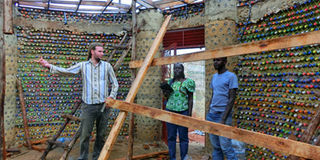Using plastic bottles to construct houses

Etienne Ssubi (left) explains how plastic bottle houses are constructed. PHOTOS BY ISAAC KHISA
They previously littered on Uganda’s roads, canals and channels- everywhere. Though it may appear peculiar, for now, the once plastic soda and water bottles that had become a menace to the environment and health will soon make beautiful houses for people to live in.
A total of 16 youth- majority in their vacation having completed their high school, together with a Germanyfounded organisation, Social Innovation Academy, have developed a plan to build 15 houses using plastic bottles to provide environmentally friendly houses.
Uganda’s housing deficit is at 1.2 million housing units, according to National Housing and Construction Company, with Kampala alone estimated at 750,000 units.
With the construction of three models now underway in the central town of Mpigi, the youth want to build 12 more houses by the end of 2015 aiming to unleash what they say is long bottled-up potential.
“The main benefit of this kind of houses is not about the cost but the environment. There are millions of plastic bottles littered all over this country especially in the major cities and if they are not adequately collected and exported for recycling, they pose a big hazard to environment and people’s health,” says Etienne Ssubi, founder of the Social Innovation Academy.
The houses, whose construction started in July last year, are round in shape and have six-meter diameter.
Where they got the idea
The construction of houses using plastic bottles is the brainchild of Andreas Froese, a German architect and environmental entrepreneur. Froese developed eco-tec, a method which utilises plastic bottles as “bricks” in the construction of houses, at latrines, and water tanks.
Faroese’s idea was to address the problem of millions of littered plastic bottles in developing nations by putting them to use.
While Froese began to develop his technique in 2001 in Honduras, the technology was first deployed in Uganda in 2010 towards the construction of a toilet by Butakoola Village Association for Development in Kayunga District, north of Kampala with the help of an NGO, Jangu International.
How it works
One house requires 15,000 half-litre and two-litre plastic bottles to be completed. This costs between Shs6m and Shs7m. This is if you buy from Kampala, where each bottle costs Shs600 to Shs800 depending on the size, cap, and the level of cleanliness.
To make the structure withstand compressive and tensile forces, the houses are being made from capped, sand-filled plastic bottles, each weighing three kilogrammes. They are stacked into layers and bonded by mud and cement, with an intricate network of strings holding each bottle by its neck, providing extra support to the structure.
Bottle caps of various colours protrude from the cement-plastered walls, giving them a unique appearance.
The houses, whose roof will sit on the external pillars to make the house strong, will be roofed using used car tyres and the floor plastered with crashed plastic bottles and egg shell to keep the room warm.
Where it has been used
The technology that is also known as “bottle brick” has been used in Columbia, Nigeria, South and Central America, Philippines, Taiwan and India.
However, consultants in engineering say although the new technology could be a solution for conserving the environment, they could not authoritatively comment on their costs compared with the houses made out of traditional bricks.
“Innovation technologies take a lot of time (to be fully developed) and for this case no one will be willing to give his or her expert opinions. We base our opinions on evidence and not mere sentiments,” Michael Daka, chairman of the Uganda Association of Consulting Engineers.
Pros and cons
“But in an event that this technology works, can this country be able to generate enough plastic bottles to sustain the demand? There will also be an issue of increased competition for the materials with other players and thus pushing their prices upwards.”
Daka also says there’s need to determine the strength of these houses based on the compressive and tension of the materials, their responds towards temperature changes, room temperature; the issues innovators say will analyse once the houses have been completed.
The innovators say plastic bottle houses are long lasting given that a plastic bottle takes approximately 300 years to decompose, something engineers say needs evidence.
“I am happy to hear that there’s a technology in this country that can protect and preserve the environment,” says, Aphwa Sebyala, the British Council Icon on climate and environment in Uganda.
“Our swamps are now full of plastic bottles preventing the flow of water, and if nothing happens, things might get out of hand, and have negative implications on our health, environment and climate change,” she says.
For now, it remains a matter of time to see whether Ugandans will adapt it at a time when owning a low-cost house remains a dream for many.




